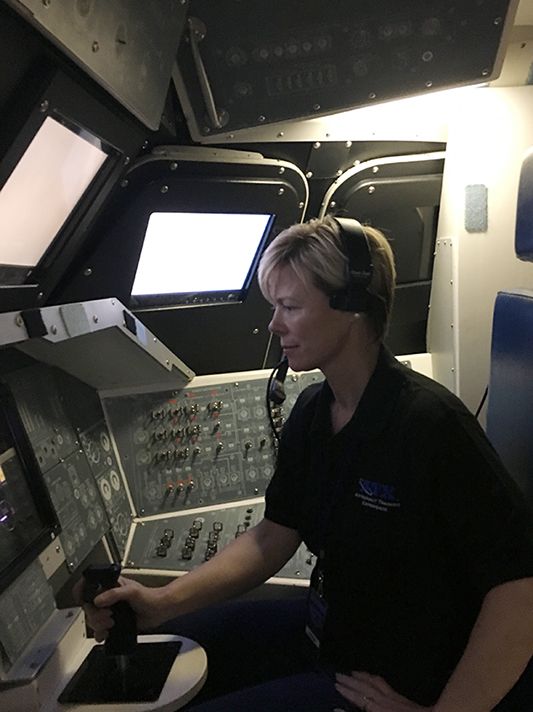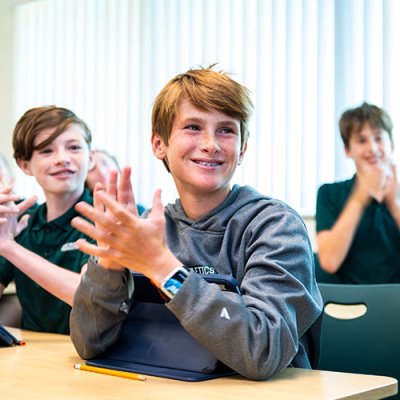

What I Learned from Astronaut Training
Source/Author: Adrianne Finley Odell, Assistant Head of School
February 24, 2017
I believe that some of the best gifts are experiences rather than things. With that in mind, my holiday gift to my spouse this year was to participate in the Astronaut Training Experience at the Kennedy Space Center. Knowing him—I knew it was right up his alley. We are both fascinated by people and their accomplishments, and one of the greatest accomplishments of the human race to date has been figuring out how to send people into space.
We spent two full days at Kennedy—the first in the Astronaut Training Experience (and by the way, we can now claim we are officially astronaut candidates!) Our second day was at Kennedy Space Center itself. The combined experience was truly unforgettable, as it provided great perspective of the monumental task around sending anything into space successfully—much less people. It is literally rocket science!
Before the accomplishment, it was something that not only seemed unlikely, it seemed impossible. Russia beat America to the punch with the successful launch of Sputnik—and then President John F. Kennedy set our country’s sights on sending a man to the moon. With a clear and compelling vision, Americans rallied like never before to rise to the challenge.
Resources were made available to get the job done and commitment to reach the goal was embraced and shared by Americans all over the country. There were over two million parts; nearly 15 miles of wire; and hundreds of switches, lights and indicators built into the command module that transported 3 astronauts to and from the moon. And this was for just the portion of the rocket that held the astronauts, the technology that went into the rest of the rocket was extensive. (I learned that just for the command module for a later Apollo mission—Apollo 14—development required 14,000 people from 8,000 different countries.)
On top of my amazing experience at Kennedy Space Center, I also had the opportunity to see the movie “Hidden Figures” this past week—as did the entire Upper School student body in honor of Black History month and as part of our ongoing diversity education efforts. The film celebrates the history-changing contributions of three African American women who worked for NASA in the first days of the space program.
Their accomplishments cannot be understated, as it is true that without them America might have taken years longer before identifying math (that didn’t yet exist) that could solve the problems to make it possible to launch people into space and bring them back safely.
It wasn’t until seeing the film that I realized that equal to the accomplishment of Neil Armstrong setting foot on the moon or John Glenn orbiting through space were the behind-the-scenes contributions of these women that made those historic moments possible. Sadly, when visiting Kennedy Space Center, these stories are lost to visitors.
It is often true that there are one or two people who get all the glory for a specific achievement when the acknowledgement belongs to others who might deserve greater credit. Alan Shepard, Apollo 14 Commander, said it well, “I think about the personal accomplishment, but there’s more of a sense of the grand achievement by all the people who could put this man on the moon.”
A visit to Kennedy Space Center is a re-affirmation of what’s possible when people unite around a shared vision. This is my number one lesson from Astronaut Training. Below is my full list to share, along with take-aways from “Hidden Figures” that our Upper School students explored in advisory sessions:
1. Vision: Very few goals can be achieved without a clear and compelling vision behind them. As individuals, we can have vision with a small “v” that is about specific aspects of our days and how we might like our days to play out. This is an important exercise for all of us. But to achieve really big goals for groups, organizations and countries, you need Vision with a big “V.” John F. Kennedy provided Vision when he rallied Americans during a speech at Rice University on September 12, 1962.
“But why, some say, the moon? Why choose this as our goal? And they may well ask why climb the highest mountain? Why, 35 years ago, fly the Atlantic? Why does Rice play Texas? We choose to go to the moon. We choose to go to the moon in this decade and do the other things, not because they are easy, but because they are hard, because that goal will serve to organize and measure the best of our energies and skills, because that challenge is one that we are willing to accept, one we are unwilling to postpone, and one which we intend to win, and the others, too.”
2. Teamwork: John F. Kennedy knew that he had to build a team comprised of the best and brightest individuals that America could engage. One of the formidable strengths of America is its ability to innovate. I believe that such innovation is possible when you can bring powerful teams of individuals together who have different skills, mindsets and abilities to think creatively about solving problems. The movie “Hidden Figures” provides us with a great example that the best solutions may not come from the stereotypical individual armed with a gold-embossed diploma from a historic institution.
During the Upper School advisory discussion following the viewing of the movie, students discussed various stereotypes that were depicted, including those related to both race and gender. Katherine Johnson, an African American human computer was the individual who developed the mathematical calculations that solved the problem of how to launch the Mercury and Apollo missions into orbit and safely return the astronauts to earth. The role she played in this critical moment of American history certainly breaks stereotypes.
Another example was Mary Jackson, who broke stereotypes and overcame obstacles around both race and gender as she took night classes and pursued promotion to eventually be named NASA’s first black female engineer. Johnson and Jackson were key members of the teams of thousands of remarkable individuals who helped America achieve its goal to land a human on the moon. The skills and knowledge that they brought to the team were immeasurable contributions toward achieving the goal. And it is likely that the diversity they brought to the table added essential perspectives that were needed to achieve America’s goal.
3. Resources: The space program is expensive. A recent guest speaker in fifth grade from NASA, Chemical Engineer Annie Meier, told the students that it costs $10,000 per pound to leave Earth. The Apollo program cost an estimate of $30 billion in 1960s currency. Kennedy’s Vision was a grand vision. The implementation of any vision requires resources to see them through, whether the resources be financial capital, intellectual capital or human capital. Taking that to the micro level in our daily lives, it is important to recognize what resources are required when setting goals and to be willing to commit to them.
4. Commitment: It is impossible to visit Kennedy Space Center without coming away with a sense of awe. As I think about it, that sense for me relates to the incredible commitment that it took to achieve what was accomplished. There were many setbacks along the way. Many heartbreaks. Lives lost. The commitment that it took to see the vision through to the realization of the goal is extraordinary. The visit left me inspired to think about other goals that aren’t nearly as audacious, and to wonder—at times when goals are abandoned, is it because the goal has changed, the commitment isn’t deep enough, or both. Examining the depth of commitment to a vision could be an important exercise to consider.
5. Belief and Beliefs: Big goals are impossible to achieve without the belief that they can be done. A lack of belief can set forth a self-fulfilling prophecy of failure. In addition, we all hold certain beliefs about ourselves and the world that have an oversized impact on our day-to-day experiences. Our Upper School students discussed their beliefs during their advisory sessions following the viewing of “Hidden Figures.” Reflecting on scenes in “Hidden Figures” where individuals stood up for the civil rights of Katherine Johnson, Mary Jackson and others, they were asked if they could remember a time when they broke with the norm to stand for their beliefs. Before John Glenn went into orbit, he questioned the accuracy of the new IBM computer that had calculated his trajectory. Instead, he believed in the computations of Katherine Johnson and wanted her to verify the accuracy of the new equipment. John Glenn believed in both the ability to go into orbit and return safely home, and held beliefs that allowed him to look beyond stereotype and enthusiastically embrace the calculations of a valued member of the team.
Vision, Teamwork, Resources, Commitment, and Belief/ Beliefs - how might we engage young people to think about the role of these principles in their daily lives? How might we as adults embrace and model them for young people? Perhaps a visit to Kennedy Space Center or viewing the movie “Hidden Figures” could serve as a foundation for further conversation.
























